Menus
- Double deceleration
- Family owned since 1972
- Solid mechanical engineering at Benelli
- Tornado with steam upstairs
- Compact and sophisticated Kawasaki 650 W1
- Sporty Benelli, comfortable W
- The evolution of the Kawasaki W1
- Technical specifications
- opinion
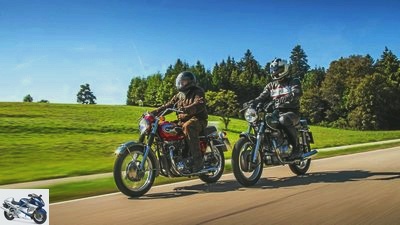
Rivas
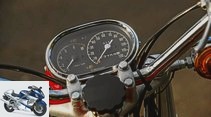
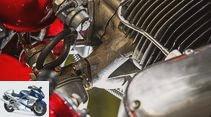
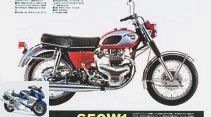
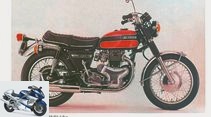
24 photos
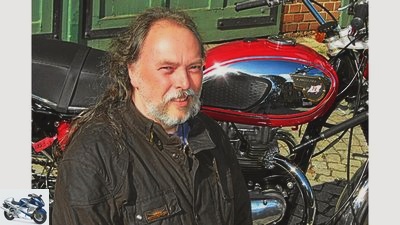
Rivas
1/24
Jurgen Kurz: As a Kawa fan with a soft spot for the Z 650, I had to have one of the rare twins at some point.
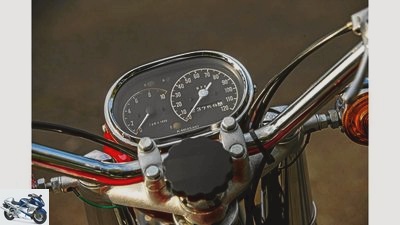
Rivas
2/24
The early W models had an instrument cluster integrated into the lamp housing. Both the tachometer and the speedometer show calmly.
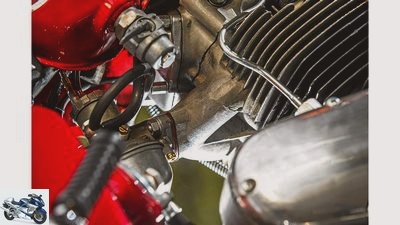
Rivas
3/24
Good to see: the flange of the W1 cast on the cylinder head with a carburetor.
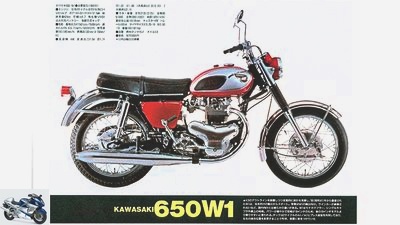
Rivas
4/24
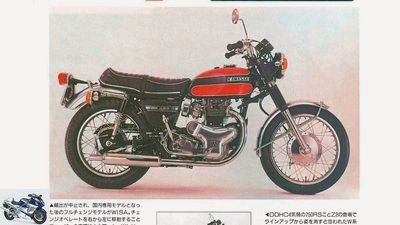
Rivas
5/24
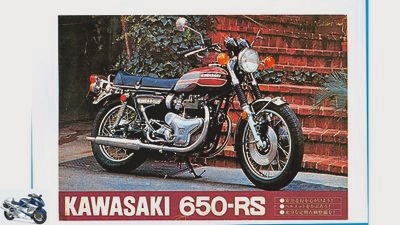
Rivas
6/24
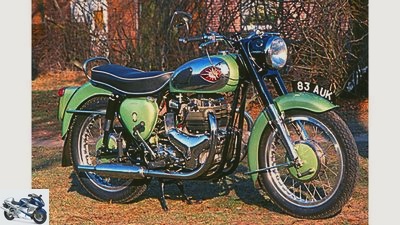
Rivas
7/24
Prototype: The BSA A7 was the inspiration for the concept of the Meguro-Twin, recognizable by many characteristic details. The stroke and bore were even the same!
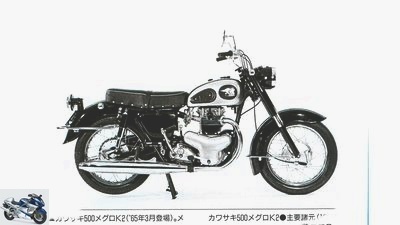
Rivas
8/24
Replica: The Meguro K1 presented in 1959 with a 500 ohv twin differed from the BSA’s design principle in only a few points.
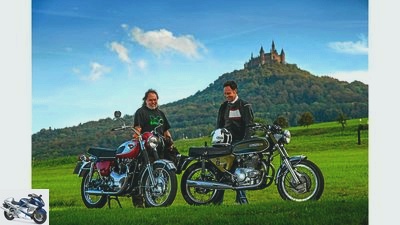
Rivas
9/24
Two independent parallel twins with character that can be seen.
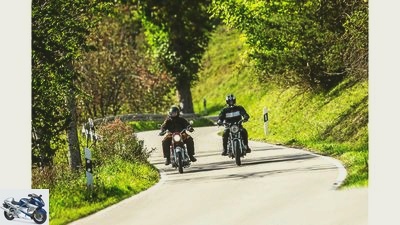
Rivas
10/24
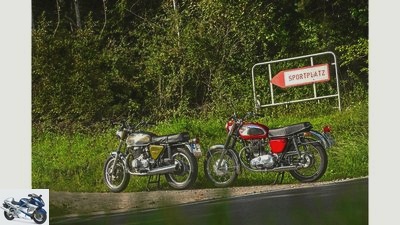
Rivas
11/24
Benelli pilots are welcome to follow the signpost. Kawa drivers rather not…
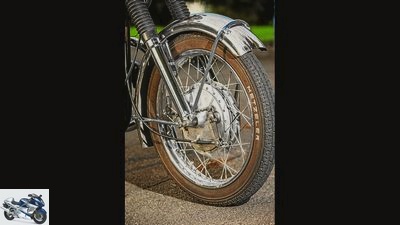
Rivas
12/24
The rather slim-looking 200 millimeter duplex drum impresses with its good braking effect.
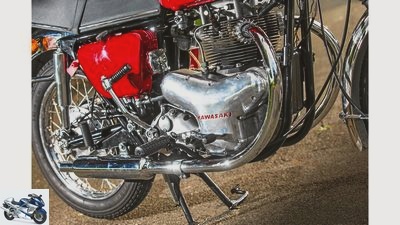
Rivas
13/24
Kawasaki 650 W1: From this perspective, the W1 with the heart-shaped engine cover reveals the similarity to English twins.
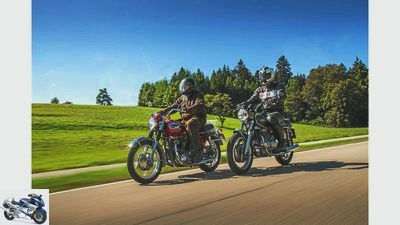
Rivas
14/24
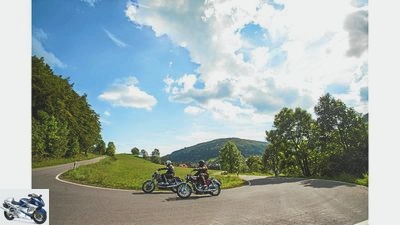
Rivas
15/24
The Benelli circles curves true to the line, the Kawasaki takes them rather lively.
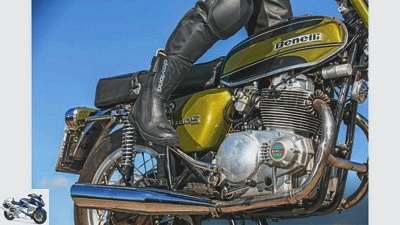
Rivas
16/24
Benelli 650 S Tornado: Sturdy shoes are recommended for kicking, the Tornado likes to hit back. The massive twin sits quite high in the chassis.
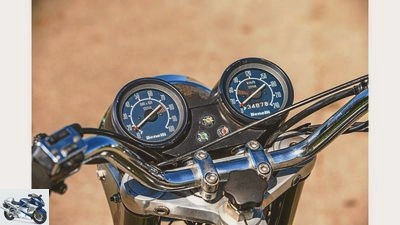
Rivas
17/24
The instruments are nice to look at. Despite the rubber mounting, the hands swing violently, which affects the informative value.
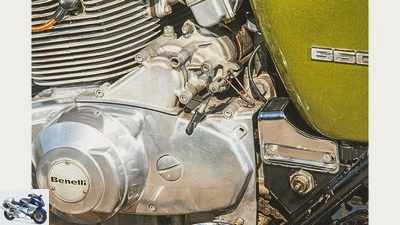
Rivas
18/24
From 1972 the Tornado had an electric starter that starts the engine via a chain that can break.
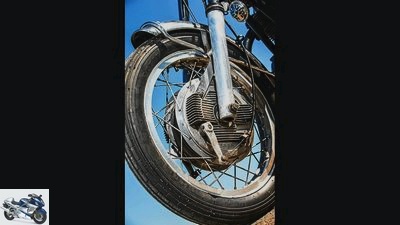
Rivas
19/24
The double simplex drum looks more impressive than it actually brakes.

Rivas
20/24
Roman pot: This engraving ennobles silencers with a special arrangement of the reflection chambers.
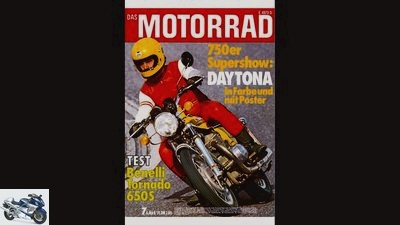
Rivas
21/24
A 72 brochure of the tornado.
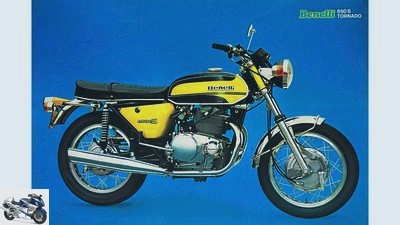
Rivas
22/24
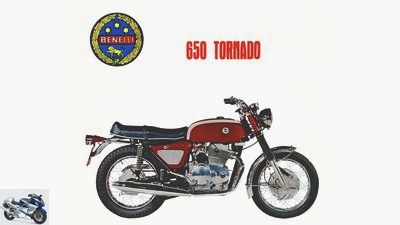
Rivas
23/24
One of the first model series with a belt-driven alternator behind the cylinders.
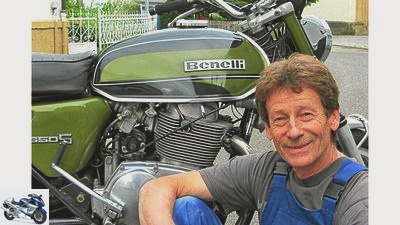
Rivas
24/24
Norbert Breuninger: The Benelli has been part of our family for 42 years, and that creates a bond.
Benelli 650 S Tornado and Kawasaki 650 W1
Double deceleration
Content of
MOTORRAD Classic editor Uli Holzwarth takes us on a trip with the two relaxed 650 twin bikes Benelli 650 S Tornado and Kawasaki 650 W1.
Stairs or elevator? Let’s be honest, whoever has the choice takes the elevator. At least that’s how I do it. And would therefore also love to hit the black start button on the B.press enelli. Not out of convenience, but out of respect. The 650 S Tornado taught me that in the days before during two or three shy attempts to start in the classic underground car park. Every kick was not only in vain, but also a little painful, because the Italo-Twin prefers to deal rather than pocket with the hesitant. Still, I had to promise Norbert Breuninger, the owner of this beautiful 1972 model, not to use the electric starter. If the two-cylinder hits back, the weak chain to the starter can tear, he had warned me.
Buy complete article
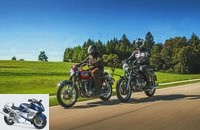
Benelli 650 S Tornado and Kawasaki 650 W1
Double deceleration
The W1 is “very British”
Jurgen didn’t notice my tension, kicking is not a big act for him, his W1 starts willingly. Good thing, because the Kawasaki doesn’t even have an electric starter. Not only in this point does the W1 stick strictly to the English models. Traditional British motorcycle construction shimmers through everywhere, which is why less reluctant contemporaries back then, in 1965, even spoke of a copy. Not without good reason, because the Kawasaki W1 was a further development based on the 500 Meguro twin from 1959. And the technicians had actually looked at the BSA A7 very carefully, the bore (66 millimeters) and stroke (72.6 millimeters) on the Meguro K1 were even identical to the British one. In the early 1960s, Kawasaki cooperated with Meguro. The aim was to use the know-how of what was then the second largest Japanese two-wheeler manufacturer after Honda to quickly expand its own motorcycle portfolio. First the joint production was relocated to Akashi, then the complete takeover took place in September 1964. The improved K2, still with 500 cc, was the last model sold under the brand name Meguro in Japan until 1965.
In the same year, the Kawasaki engineers started working on the ohv-Twin, which with a 74 mm bore and an unchanged stroke of 624.5 cm³ was supposed to stand up to the British competitors who, with their 600 and 650 cc, were particularly popular in the USA. From a technical point of view, however, the concept of the bumper motor copied from BSA remained. However, with some decisive modifications in detail that largely eliminated the weaknesses of the original. And of course metric threads, which Jurgen also found “very likeable” during the restoration. The twin bumper, which was sold in Japan and the USA from 1966 as the Kawasaki 650 W1, has a three-part 360-degree crankshaft with double roller bearings in a vertically split housing, with cast iron cylinders and an aluminum cylinder head. The camshaft, which is located halfway up behind the crankshaft, operates the two valves via push rods, tappets and rocker arms. The characteristic, heart-shaped right side cover conceals the oil pump, camshaft and interrupter drive, while the alternator positioned in front of the crankcase is driven by a chain. Also typically English is the primary drive on the left-hand side, which transmits the power via an oil bath clutch and duplex chain to the four-speed gearbox housed in a separate housing with right-hand actuation.
Jurgen did not give much thought to any of this when he bought his 1967 W1 on eBay around twelve years ago, for 3200 euros in a desolate condition. “The technology wasn’t that important to me at first, I thought the sound was cool, and I also found the look very suitable for a chopper conversion,” says the Swabian with a grin. Knowing well how horrible the former plan sounds today. After studying the history of the Kawasaki, which is rare in this country, and was able to determine that the spare parts supply is quite acceptable thanks to Ralf Gille’s commitment and the current possibilities via the Internet, the 51-year-old thought better of it. The machine was completely dismantled and rebuilt within three years, with the support of friend Jurgen Reichelt. The work was worth it, today Jurgens W1 is in perfect shape again. “There are very few parts that are not original on this 67 model. This includes the replica silencers of a later model, the side rubbers on the tank, the seat cover and the bellows on the fork, ”says Jurgen, listing the differences.
Family owned since 1972
I don’t even need to look for something like that at Norberts Benelli, his tornado has a completely different story. It is a model from the second series, with 12-volt electrics, an electric starter and a more elegant tank-seat line. His uncle – Norbert’s father comes from Italy – bought the Tornado new in 1972 and drove it almost every weekend from Palermo to Milan to see his beloved – makes around 3,600 kilometers there and back! “Of course, that only works with a reliable motorcycle and a level-headed driving style,” says the 55-year-old, paying tribute to both the machine and the careful treatment of his uncle, who always kept it at a maximum of 150 km / h. Thanks to this prudence, the Tornado has so far covered a whopping 234,000 kilometers “without ever having to open the engine!” Except for the usual wear parts, Norbert’s Tornado is still in its original condition. And is still a classy family member who bears his age with great dignity, which is emphasized by the light patina.
“The greatest enemy of a tornado is the exaggerated maximum speed specification of 180 km / h. Or rather, a driver who wants to try it out over longer distances. Anyone who asks her to do this will destroy her at some point, ”says the car mechanic, who has been cherishing and caring for the family jewel for many years.
Solid mechanical engineering at Benelli
However, that does not mean that the mechanics of the tornado are vulnerable. On the contrary, if handled correctly, the engine is considered to be very stable, confirms Wilfried Blothe, who as a “Benelli farmer” in the scene is also the first port of call for tornadoes when it comes to parts (www.benelli-bauer.com ).
So let’s take a quick look at the technology and history of the Italian parallel twin, which – in contrast to the Kawasaki – has little in common with the classic English design principles. This is remarkable because Benelli first presented the Tornado to the public almost simultaneously with the Kawasaki W1 in 1965. The Italians were also targeting the English competition with their new twin, which they wanted to steal away from customers, especially in the high-volume US market. However, it wasn’t until the end of 1969 that the series tornado rolled off the production line – much too late to do anything else in the States, where the four-cylinder 750s had already been torn from the hands of Honda dealers.
Against this hype, which soon spilled over to the old continent, the Benelli twin had a difficult time. The very short-stroke engine – the piston stroke is only 58 millimeters with a bore of 84 millimeters – with its robust and maintenance-friendly construction is convincing. The extremely solid looking motor housing can be divided horizontally; after removing the top cover, the mechanics see the innards as if they were on a tray. Starting from the front, these are the camshaft with the worm drive of the oil pump, behind it the crankshaft rotates with the centrifugal mass in generously dimensioned roller bearings, the connecting rods of which run on needle bearings. The generously dimensioned piston pins are also stored in it. The primary and camshaft drives are helical gearing. In contrast to the Kawa, the Benelli has a five-speed gearbox integrated in the engine housing. The disassembly works without special tools, all bearings are held in place by circlips and pins.
Tornado with steam upstairs
Which I have certain doubts about in the saddle of the Tornado, because worrying noises reach my ears when idling and coasting. The 234,000 kilometers do not seem to have remained completely without a trace. However, the metallic knocking disappears under load. Great, then, as Norbert advised, I can pull the cable properly. The Benelli needs that too, downstairs – the wildly swinging Veglia tachometer only allows estimates – there is no question of whirlwind, there is more of a calm.
This is where the Italian Kurzhuber differs significantly from the English slackers, who shovel noticeably more torque to the rear wheel in the lower rev range. She wants about 3500 tours, the Benelli, then she pulls off powerfully, almost roughly, only to turn more uniformly to the red area, into which she willingly drives the needle. This revving was already noticed in the test in “DAS MOTORRAD” 7/1974, in which the “Adria-Knurrhahn” was even required 8000 rpm and more – without any negative consequences for the mechanics. However, I spare Norbert’s marathon machine such tortures, I prefer to step into the next gear of the exact gearbox that can be shifted over a somewhat longer distance with my right foot and keep the tornado in its comfort range of around 3500 to 5500 tours. Here the muffled and pleasantly sonorous sounding twin develops enough steam for fun hours on country roads without the vibrations being a disruptive factor. With changing load conditions, they tend to be more on the material than on my nerves, which also explains Norbert’s lack of useful add-on parts such as mirrors and indicators.
Compact and sophisticated Kawasaki 650 W1
Jurgens Kawasaki has not yet thrown these things off himself, although the W1 feels at least as edgy on higher tours as the Benelli. In both cases, however, I don’t find these signs of life really annoying when chasing bends. More like the somewhat stubborn transmission of the Kawa, the four gears want to be engaged with care and more power, but this does not always work silently. It’s a shame, because the Japanese has clear advantages in terms of running culture, her twin runs mechanically much quieter than the Tornado. Maybe it’s because the longer-stroke Kawasaki even seems a tad more maneuverable than the Benelli, although in a direct comparison I can see differences in character rather than performance. With both machines I feel well motorized on winding country roads, although the Kawasaki doesn’t feel quite as at home in the lower third of the speed as an English lady.
Apart from that, the W1 makes every effort to make it as comfortable as possible for the driver. Provided that it measures no more than 1.75 meters. For taller people, and therefore also for me, it gets pretty tight behind the deer antler handlebars, I have to put my very best on the hard step of the bench to accommodate my legs to some extent. Nevertheless, I cannot fail to see how lightly the W1 works in bends, how calm the instrument cluster shows, how easy it is to operate the clutch and handbrake. The front duplex drum, the counterpart of the Benelli, a double simplex drum, clearly stands out. Both the dosage and the braking effect at the front are significantly better on the Kawasaki.
Sporty Benelli, comfortable W
Rivas
Benelli pilots are welcome to follow the signpost. Kawa drivers rather not…
Nevertheless, I just feel more comfortable on the Benelli, the narrow tank and the relatively high, non-tiered bench seat give me enough freedom of movement when sharpening corners. It doesn’t bother me that I have to pull a little harder on the less protruding handlebars to ask the tornado to tilt, especially since it throws itself into the radii to inspire confidence. No wobbling, no rocking, the tightly cushioned Italian drives exactly on the desired line. And still swallows the grossest distortions of the asphalt – the compromise between driving stability, handiness and comfort has been well achieved by the Benelli engineers with the Tornado.
In this respect, the Kawasaki reveals the biggest differences in comparison. It takes life on the country road quite lively, the fork and the spring struts lack sufficient damping. And this gives the pilot precise feedback, which is also not entirely innocent of the unusual innerspring seat bench. Jurgen is not bothered in the least, as his happy laugh tells me. He loves the robust sound of the W1, its sociable nature, the two have grown together over the years. Like Norbert and the Benelli, although it doesn’t make it as easy for a newbie as the W1.
The Tornado is more idiosyncratic, it demands more from the pilot, pays back the higher stakes with the more intense driving experience. In other words: the Benelli will be especially happy for those who like to take the stairs instead of the elevator.
The evolution of the Kawasaki W1
Kawasaki has built a total of 26,289 of the 650 parallel twin. Nevertheless, these models are little known in this country. W specialist Ralf Gille therefore kindly provided us with an overview of the model’s history.
Ralf Gille Motorcycles & Engineering,
Feuerbachstrasse 21, 60325 Frankfurt,
Phone: 0162/2 50 94 54
www.gille-restauration.de
W1: Single carburetor model, instrument cluster, smooth seat, long exhaust pipes similar to BMW, sweeping mudguards, wheels 1.65 x 18 at the front, 1.85 x 18 at the rear. 1965: Pre-series of 55 pieces, 1966: 2422 pieces, 1967: 797 pieces, 1968: 8 pieces.
W1P (police): With a single seat, luggage rack and box, siren, red lights and crash bars. Technically like W1, but fork without bellows with sleeves. Police speedometer. 1966: 22 pieces, 1967: 192 pieces, 1968: 112 pieces.
W1S: Japanese dual carburetor model. Without instrument cluster, separate instruments up to 1968 identical to the TT, from 1969 similar to H1 and A1 / A7, but with different scales, some with two-tone bench seats. Exhaust from 1968 with Long Mufflers (English style, not like the US-W1). 1967: 160 pieces, 1968: 1929 pieces, 1969: 2759 pieces.
W1SP (police): With a single seat, luggage rack and box, siren, red lights and crash bars. Technically like W1S, but fork without bellows with sleeves. Police speedometer. 1969: 274 pieces, 1970: 206 pieces.
W1SS: Single-carburetor model, identical to the W2SS, but with a single-carburetor cylinder head. Still with instrument cluster, short mufflers, shorter mudguards, 19-inch front wheel (1.85 x 19), rear 2.15 x 18. Tuck 6 roll bench, modified oil tank. Fuel tap outlets moved forward as with W2SS. Purely export model for the USA and Australia. Until 1968 with Short Mufflers, from autumn 1968 with Long Mufflers. 1967: 201 pieces, 1968: 50 pieces.
W2SS: Identical to the W1SS, but with a twin-carburetor cylinder head and individual air filters. Until 1968 with Short Mufflers, from autumn 1968 with Long Mufflers. From autumn 1968 also with a painted tank and painted lamp holders. 1967: 1221 pieces, 1968: 729 pieces, 1969: 41 pieces, 1970: 5 pieces.
W2P (police): With a single seat, luggage rack and box, siren, red lights and crash bars. Technically like W2SS, but fork without bellows with sleeves. Police speedometer. 1967: 12 pieces, 1968: 48 pieces.
W2TT: Scrambler version. Technically like W2SS, but high pipes, 1968 model with chrome sides on the tank and individual W1S instruments. Changed frame to accommodate the exhaust system. Fittings on the 1969 model similar to H1 and A1 / A7, but different scales and painted tank as well as modified exhaust system. 1968: 624 pieces, 1969: 15 pieces.
W1SA: Two-carburetor model, gearshift shifted to the left side through the swing arm, instruments similar to Kawasaki S1 / S2, modified front brake, exhaust shape like the late W2SS, but with rubber bearings. Handlebar switch changed. From autumn 1972 already equipped with W3 silencers (cone type). Electrics changed, now with two ignition coils and two breakers. 1970: 3663 pieces, 1971: 4463 pieces, 1972: 1744 pieces.
W1SAP (police): With a single seat, luggage rack and box, siren, red lights and crash bars. Technically like W1SA, but fork partially without bellows with sleeves. Police speedometer. Was also used in the military police in Japan and Australia. 1971: 121 pieces, 1972: 86 pieces.
W3: Technically like W1SA, but tank without side radiator holder. Instruments and fork similar to Z1, double disc brake, modified seat. Changes to the 1974 model: seat sample, choke lever and labels on the indicator lights. 1972: 1103 pieces, 1973: 1728 pieces, 1974: 1599 pieces.
Other differences: The single-carburetor engines produce 50 hp, those with two carburettors three more. Up to the year of construction 1969 a roller bearing was used on the crankshaft on the left and a ball bearing with 8 balls on the right (standard bearing).
Starting in 1970, ball bearings with 12 balls were used on the left and right (we have them reproduced). Furthermore, the tensioning mechanism of the lima chain was changed from the W2SS onwards, and the delivery rate of the oil pump was increased at some point. The early W models have a gearbox with the identification W1M. From W2SS onwards, better shiftable gears with the identifier W2M were used.
Technical specifications
Benelli 650 S Tornado (1970-1976)
Engine: Air-cooled two-cylinder four-stroke in-line engine, an underlying camshaft, two valves per cylinder, actuated via bumpers and rocker arms, bore x stroke 84 x 58 mm, compression 9.6: 1, displacement 643 cm³, output 33 kW (45 PS ) at 6500 rpm.
Power transmission: Multi-disc oil bath clutch, five-speed gearbox, chain drive
Landing gear: Double loop frame made of tubular steel, telescopic fork at the front, two-arm swing arm with two spring struts at the rear, wire-spoke wheels with aluminum rims, tires 3.50-18 at the front, 4.00-18 at the rear, double simplex drum brake at the front, Ø 230 mm, simplex drum brake at the rear, Ø 200 mm.
Mass and weight: Wheelbase 1400 mm, weight with a full tank of 220 kg, tank capacity 12 l
Top speed: about 170 km / h
Price 1974: 6295 marks
Kawasaki 650 W1 (1966-1975)
Engine: Air-cooled two-cylinder four-stroke in-line engine, a camshaft below, two valves per cylinder, actuated via push rods and rocker arms, bore x stroke 74 x 72.6 mm, compression 8.7: 1, displacement 624 cm³, power 37 kW ( 50 hp) at 6500 rpm.
Power transmission: Multi-disc oil bath clutch, four-speed gearbox, chain drive
Landing gear: Double loop frame made of tubular steel, telescopic fork at the front, two-arm swing arm with two spring struts at the rear, wire-spoke wheels with steel rims, tires 3.25-18 at the front, 3.50-18 at the rear, duplex drum brake at the front, Ø 200 mm, simplex drum brake at the rear, Ø 180 mm.
Mass and weight: Wheelbase 1415 mm, weight with a full tank 200 kg, tank capacity 15 l
Top speed: about 180 km / h
price 1967: 4830 marks
opinion
Norbert Breuninger on the Benelli 650 S Tornado
The Benelli has been part of our family for 42 years, and that creates a bond. Especially since it convinces with a high level of reliability if you treat it well. The Tornado is a motorcycle with character that demands a lot, but gives even more if you get involved. That is what makes this machine so appealing to me. You don’t drive on the Benelli, you drive. And consciously, with all your senses. I also like the fact that you don’t see a tornado on every street corner.
Jurgen Kurz about the Kawasaki 650 W1
As a Kawa fan with a weakness for the Z 650, I had to have one of the rare twins at some point. The W1 is something special for me, especially the sound and its handiness do it to me. In addition, I dealt very intensively with history and technology during the long restoration, which has led to a close bond over the years. In the meantime, my buddy Jurgen and I have bought more W models, and they will probably not be the last.
Related articles
-
Presentation of the Benelli Tornado 900
Presentation of the Benelli Tornado 900 Extra Cool The traditional brand Benelli is back: with a potent three-cylinder, unusual design and …
-
Driving report Benelli Tornado 900 Racing
Driving report Benelli Tornado 900 Racing The one-man-show Peter Goddard started in 2001 as a lone fighter in the Suerbike World Championship. With a small, dedicated …
-
Driving report Benelli Tornado Tre Limited Edition
Driving report Benelli Tornado Tre Limited Edition Everything completely different Away from the uniformity, out of the shackles of mass production: MOTORRAD drove world-exclusive …
-
Driving report Benelli Tornado 1130
Rossen Gargolov Driving report Benelli Tornado 1130 Wind force 1130 Don’t worry, with this heading everything is correct. Because the 900s tornadoes …
-
On the move: Benelli 750 Sei, Honda CBX 1000, Kawasaki Z 1300
Bilski 17th photos Bilski 1/17 Who is the widest in the whole country? The angle of spread of the driver’s legs provide information. Bilski 2/17 With…
-
Kawasaki ER-6n and KTM 690 Duke in comparison
14 pictures 1/14 Two middle class naked bikes in the verifying test. Who has the edge in the end – the Kawasaki ER-6n or the …
-
Test Benelli Tornado 900 Limited Edition
Test Benelli Tornado 900 Limited Edition In the eye of the hurricane »In the first, limited» edition of the? Tornado to break into the established…
-
Benelli Tornado Tre 1130 from 2008 – Technical data
Benelli Tornado Tre 1130 Specifications since 2008 Technical specifications engine Number of cylinders, type 3, in-line engine power 111.8 kW / 152.0 hp…
-
Archive cult bike Benelli Tornado 650 Benelli Tornado 650 An Italian fad – showing prototypes that will only go into production years later – has …
-
Benelli Tornado 900 Tre RS test
Jahn Benelli Tornado 900 Tre RS test Rock and soul Your three-cylinder plays rock ?? n ?? Roll, your cover flatters the soul. A feast for the senses, the…